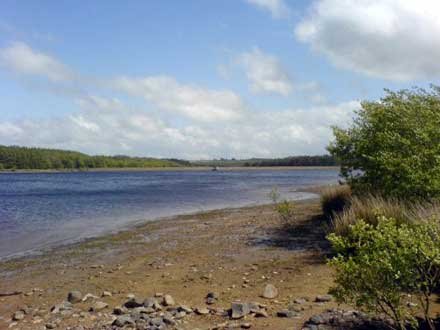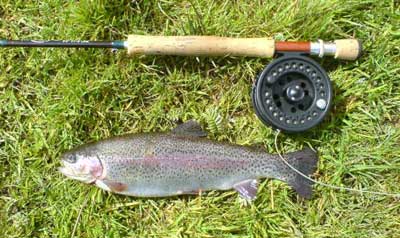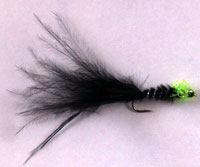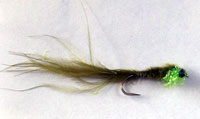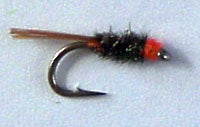The Tao (‘The Way’) of the TroutI HAVE A demanding job: high stress, long hours, noise, dust. Sometimes the rewards are there, but mostly it’s just hassle. When things start to get on top of me I need to escape; to the edge of the land to surf, or to the wild places to fish. Increasingly I need simplicity, minimal tackle, the freedom to wander as I like, and fly fishing fills this need perfectly. It is the antithesis of the modern, high tech world of specimen hunting with its designer baits, electronics and mounds of luggage.Come with me for an afternoon and unwind A boisterous wind roars across the open expanse of the airport and buffets me as I head for my car. Fleets of clouds scud across the bright sky and in the distance towering grey masses hold the threat of a drenching. Ten minutes later I’m dropping down into the lush pastures of middle Wharfedale; the soft underbelly of this most beautiful of dales. It is roamed by the pampered bleach-blonde wives of solicitors in their 4 x 4s and coach parties of pensioners in a vain search for the real Emmerdale. I cross the river at Pool and climb the burly shoulders of the dale, to the rough moorland, the dry stone walls and the sheep nibbled turf. I descend again into the upper reaches of the Washburn valley, to the village of Fewston and its reservoirs.
I’ve come to love these great, wild, upland reservoirs, with their acid, peat stained water, their huge skies and roaring winds. They are an unguent for my soul. Built to provide clean water for the teeming slums of Leeds and Bradford they represent the pinnacle of Victorian civil engineering and, somehow fittingly, they inundated the water-driven mills of the early industrial revolution as they ushered in the age of steam. A glance over the dam wall as I cross it reveals few anglers. On days like today the Washburn valley isn’t for the faint hearted. An acquaintance of mine checks the trees in Bradford before a trip and if the leaves are moving he wimps out, fearing that this soft lowland zephyr will be usurped by an unruly hooligan of a gale at Fewston. As I change in the car park my resolve is tested by a heavy shower, but my waterproof carapace shrugs it off and I stride through the woods to the Western bank of the reservoir. Fewston is big, about 140 acres, and it takes the waters of the huge, spectre haunted expanse of Blubberhouses moor from its little brother Thruscross and passes them on to its gentler sister Swinsty. Between them the 3 reservoirs offer over 400 acres of fishing with Thruscross being run as a wild brown trout fishery and its siblings as put and take rainbow fisheries. A place to avoid on a wild winter’s night I pass two other anglers as I walk down to the short west arm which takes the waters of Gill beck. That gives us about half a mile of bank each: adequate elbow room! In its upper reaches Gill beck is forded by the old Roman road and, not far from this, pale and shaking motorists have reported swerving to avoid the ghostly forms of Roman auxiliaries trapped in a doomed march to relieve their comrades on Hadrian’s wall. This together with the great looming Brocken Spectres make Blubberhouses a place to avoid on a wild winter’s night. The wind is blowing a hooley down the west arm so I stop about 200 yards down from the point and tackle up in the shelter of a stunted alder. This is no place for delicate tackle. I’m using an 8 weight Airflo Classic Plus rod, a long belly weight forward line, a 5ft Airflo poly leader and 10 ft of 8lb Airflo Plantinum G4 Fluorocarbon. In these conditions I’d always go for a short belly weight forward line, but as I don’t posses one I’ll have to make do. We anglers are victims of our own conceits. 90% of us can’t aerialise a long belly line effectively in anything but perfect conditions, but because the icons of our sport use them to achieve prodigious distances we demand the same, and suffer for it. A word on fish location These large reservoirs often appear featureless with their long expanses of exposed mud. The secret is to exploit the topography of the land before it was flooded. Look for old lanes, walls, field barns and streams. On misty Autumn evenings I’ve sat where the Roman road dips into the old valley hoping to see ghostly forms trudging up out of the depths. My only reward was the occasional prickling of the hairs on the back of my neck and plenty of trout! This afternoon I choose a spot where a linear scattering of stones on the bank and emergent weed in the water indicate the line of an old wall. Normally I wouldn’t enter the water for my first few casts, but on this occasion a sparse line of weed about 5 yards out decides me to wade out so I can fish over it. There’s a lot to be said for imitative fishing and in the warm days of Summer a spider or buzzer pattern drifted around on the breeze can be deadly, but it’s still late spring and we’re a thousand feet up. Let’s be sensible about this! I open my lure box and select a small black fritz concrete bowl. This is my own version tied with a long marabou tail to give movement and a lime green fritz ‘thorax’ to give an aiming point and increased visibility in coloured water. I choose a slimmer bodied version that has only one layer of lead wire as the water here is not that deep. I wade out to the weed line and make my first cast. I’m not going for distance and I aim to drop the fly just beyond the end of the weedbed, probably no more than 10 yards out. Trout are unlikely to swim through the denser weed and so will swim around the obstruction. This gives a ‘pinch point’ just off the end of the weedbed where a concentration of fish is likely to occur. Sure enough on my second cast there’s a solid thump followed by the rapid, jagging fight of a decent rainbow trout. I soon net a plump trout of just over a pound, which I despatch in the net before unhooking it and transferring it to my bass bag.
Exploring the water I now commence to explore the water in front of me thoroughly. Working along the bank then gradually extending my casting distance out to about 25 yards – my limit in the current conditions. The wind is coming from an almost perfect direction, diagonally over my right shoulder, but it’s strong and blustery. It’s important to remember that you don’t need to use much more force when casting into a wind. In fact I have to consciously pause longer on my back cast to allow the line to straighten fully before making my forward cast. The strong wind means that the line is travelling much slower relative to ground than you might expect. I help matters by making a haul on the back cast and watching the line to ensure it extends fully before making the forward cast. The haul is the classic technique for increasing line speed and hence distance when fly casting. Its best described as a gentle tug on the line as the rod is reaching its full compression in the cast. This stores more energy in the rod which is then transferred to the line, increasing the distance it travels before hitting the water. Beginners often have trouble with this technique. The secret is to say the words ‘down-up’ as you carry out the haul. The left hand moves smoothly down and then smoothly back up as you say the words. The forward cast requires no effort at all. I simply let the rod spring back and relax my wrist slightly to open out the loop of line to act as a sail in the wind. The retrieve is a slow ‘figure of eight’. This technique was drummed into me by my good friend Steve Rhodes, one of the finest fly anglers in the country and now chairman of the Grayling Society. At first try to keep the retrieve as smooth and uniform as possible. I learnt this several years ago in a dramatic fashion. After a dour evening I made a last cast and retrieved by winding my line slowly back on to the reel. I was gobsmacked to feel a good solid take and land a fish. I tried it again and hooked another fish. Since then I’ve always made a conscious effort to make my retrieve as smooth as possible, only adding jerks and changes of speed if that doesn’t work. Slow means slow! Count to three on each leg of the figure of eight in slow waltz time: one-two-three, one-two-three. At this time of the year and in these unsettled weather conditions the trout are unlikely to be aggressive, so start slow. You’re less likely to spook fish and you can always speed things up later. Over the next hour I land five decent trout and lose a couple due to them throwing the hook. I don’t strike, but continue to retrieve until everything goes solid or the fish makes a dash for freedom. I then start to get abortive takes: quick taps which don’t develop into a solid take. Time to ring the changes. I try speeding up the retrieve without success so I change fly to an olive green Concrete Montana. This results in two more fish then the tap tap tap starts again. Let’s relax for a while! I thread a bung onto my leader, fix it at about 4ft and tie on an Anorexic Diawl Bach. I cast out and allow the wind to drift the fly in a slow arc in font of me. The secret is to start close in and gradually work out to your maximum casting range. That way you’re not spooking fish by constantly casting over them. I find this a really relaxing way of fishing. The bung gives me something to focus on, but my mind can wander allowing my subconscious to keep a watchful eye on the small fluorescent blob moving slowly across my field of vision. Over the next hour I change the depth, swap the Diawl Bach for a buzzer and try a slow retrieve. The trout show no interest, but I do catch a couple of reasonable perch. Looks like it’s time for a move. I re-tie my black lure and start to work my way along the bank. The secret is to cast short initially and gradually cast further and further. Move quietly and don’t wade until you’ve explored the margins. Trout will quite happily hang out in a couple of feet of water and it is the shallows that offer much of the food in these upland reservoirs. This is classic reservoir bank fishing. Try a spot for 15 minutes and move. Keep on moving until you find fish. Fish for a while until the takes dry up then move on. Once I’ve taken my limit I don’t bother with a net and simply release the fish in the water. If you don’t want to take fish this offers the ultimate in mobility. A spool of line and a fly box in your pocket, with a pair of snips and some forceps on a zinger are all that you need. I slowly work my way towards the West Arm, taking a couple of fish along the way. Well before I reach it the wind roaring round the point makes life too difficult so I retreat back to my starting point and begin to work my way back to the car park. Over the next 100 yards or so I catch a few more fish, but a front is moving in, battering me with squally showers and violent gusts of wind. After being hit by my fly a couple of times I decide to call it a day and head back to the car. Its been a good afternoon: plenty of fish, but enough of a challenge to make me have to think about what I’m doing. The Tao The tao of the trout is not a difficult way. As you progress along it you learn strategies which when applied logically virtually guarantee you a fish or two. It is important not to become slave to a single method for that way lies boredom and sterility. Practice to be quiet, make small subtle changes, be slow and smooth. Let the sharp rhythm of the cast and the slow counterpoint of the retrieve become your mantra. Open your mind to the beauty of your surroundings; stop, look, listen. That way lies peace, and nirvana… DressingsConcrete Bowl (Sean’s version)
Tail: black marabou Body:black marabou, tied in at the tips Rib:stretched pearl tinsel Thorax:lime green Fritz, trimmed short Thread:black | |||
|
Concrete Montana
Tail:olive marabou Body:olive marabou, tied in at the tips Thorax:lime green Fritz Thorax Cover:olive marabou Thread:black | |||
|
Diawl Bach (Sean’s version)
Tail:a few ginger cock hackle fibres Body:a single peacock herl (tie short and trim after tying to slim the profile) Rib:stretched pearl tinsel Thread:fluorescent orange |
Welcome!Log into your account










